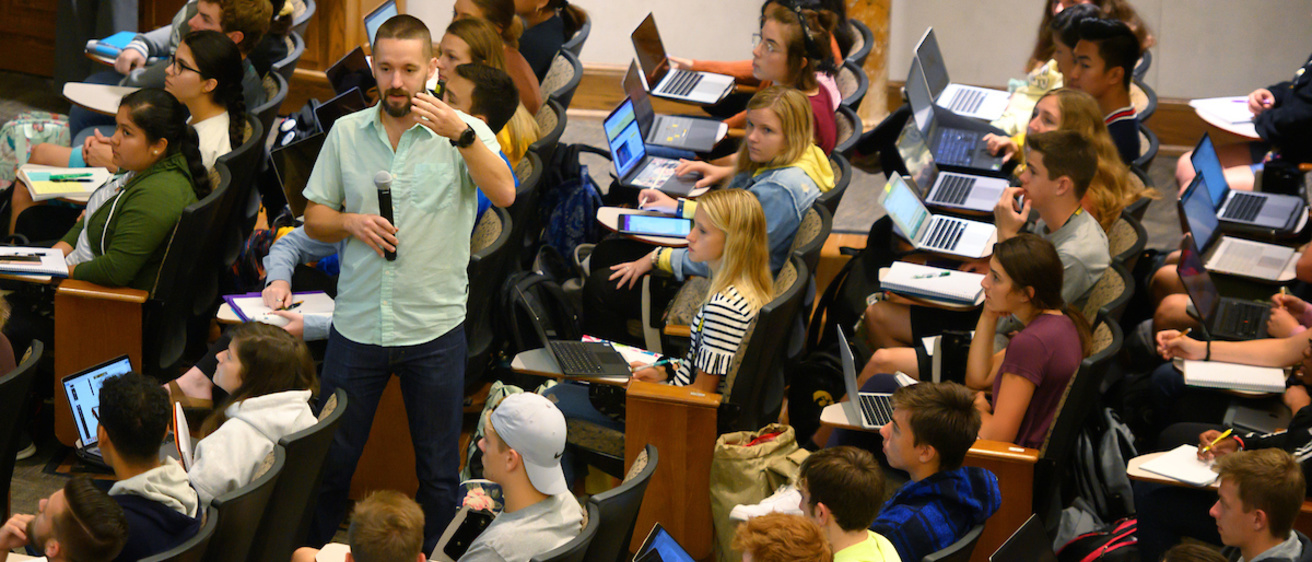
Breadcrumb
Creating connection in large lecture courses
Effective feedback is critical to student success, but providing meaningful, timely feedback to hundreds of students is a challenge for instructors—especially if student engagement data is not readily accessible.
Connecting with students in large courses is a familiar task for Adam Brummett, a lecturer in the UI Department of Chemistry. In 2020, he collaborated with the Office of Teaching, Learning, and Technology (OTLT) Research and Analytics team to develop a more efficient system, leveraging the millions of data points created by students’ interactions with learning technologies.
“Learning analytics hold the promise of offering valuable insights into the complexities of the learning processes, enabling educators to make data-informed teaching decisions and offering customized support for each student’s academic success,” says Jane Russell, director of OTLT Research and Analytics.
From dashboard to message development
The team first designed an instructional analytics dashboard for Principles of Chemistry I. The dashboard aggregated data from multiple instructional technologies—ICON, Zoom, Panopto, and online homework platforms—to generate near real-time reports about students’ engagement patterns and interactions with materials and tools. Brummett gained insight into how every student engaged with different course materials and activities, furthering the correlation between those engagements and performance.
The following year Brummett and the Research and Analytics team expanded their work on the dashboard by launching learning analytics-based, personalized feedback in the course. The primary goal was to provide feedback based on specific student engagement behaviors—gathered from the learning analytics—and guide them with strategies that would lead to better learning outcomes.
Examples of the personalized feedback messages included recognizing a positive behavior such as engaging with lecture videos, reminding the student of key materials if they hadn’t accessed them, and providing resources or learning tips in areas the student needed more support.
Brummett consulted with the OTLT Center for Teaching to craft the messages.
“We had two primary considerations in strategizing the personalized messages: timing and the learning aspect we wanted to focus on,” says Sara Nasrollahian, assistant director in the OTLT Center for Teaching.
Nasrollahian explains that the timing often coincided with assessments, so students could reflect and use the content to improve their learning and performance.
“Students didn't receive generic, repeated messages; instead, they could see their learning process through personalized messages,” Nasrollahian says.
They continued to improve and refine the messages each subsequent semester. By 2022, Brummett had expanded the scope and reach of the intervention, sending regular messages to hundreds of students in Principles of Chemistry I and II.
Cultivating connection
Student response was overwhelmingly positive. Some replied with a brief “thank you” while others shared challenges they’d experienced and how the message made them feel connected to the course.
“Personalized messages can initiate and establish a connection, which opens new ways of communicating and reduces barriers to understanding chemistry and science,” Brummett says.
Brummett also points to research showing that when students feel connected to a community, there’s a greater likelihood they’ll persist in a field.
Expansion on campus
Brummett and Russell received funding through an Innovations in Teaching with Technology Award—sponsored by Academic Technology Advisory Council—to expand learning analytics-based feedback at Iowa.
The next phase of the project entails developing a learning analytics infrastructure that enables instructors to send personalized emails throughout the semester based on behaviors and performance goals. As the analytics infrastructure is rolled out to campus, even more students in large courses will benefit from individualized feedback.
“I can make an announcement in class or send a mass email, but it doesn’t resonate until the message is more personal,” Brummett says. “The dashboard helped us create that personalized experience.”